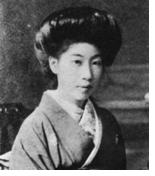

HISTORY OF HAIKU
10 haikuists and their works
Chapter 8
Hisajo Sugita (1890 ~ 1946)
 Director of Hototogisu magazine, Kyoshi Takahama intended
to propagate haiku to women. He instituted the section "The Kitchen
songs" where were published women's haikus; there were published such
excellent poets as Kanajo Hasegawa (1887 ~ 1969) and Midorijo Abe (1886
~ 1980).
Director of Hototogisu magazine, Kyoshi Takahama intended
to propagate haiku to women. He instituted the section "The Kitchen
songs" where were published women's haikus; there were published such
excellent poets as Kanajo Hasegawa (1887 ~ 1969) and Midorijo Abe (1886
~ 1980).
Among other female poets, Hisajo Sugita showed talent and she exploited new possibilities.
One of the characteristics of the Taisho Hototogisu poets is the technique to create a pseudo-perspective by combining the distant view and the foreground.
Dew on a leaf of taro.
The mountains rectify
Their shadows.
Dakotsu Iida
Depth of the valley
How high a butterfly passes!
Sekitei Hara
These haikus are made up as follows:
"The shadows of the mountains" (distant view) + "Dew on a leaf of taro" (foreground)
"Depth of the valley" (distant view) + "a butterfly" (foreground)
I think that, in these haikus, the eyes of the poets are focused on the distant views. They intended to present the imposing image of the mountains or of the deep valley. The foregrounds such as "Dew on a leaf of taro" and "a butterfly" play secondary parts and decorate the distant views, making beautiful harmonies like decorative flowers in front of an altar.
But in Hisajo's haikus, when coexist the distant view and the foreground, each element tries to win recognition by itself, one never serving as a foil for the other.
Autumn fresh air
Arrive at hydrangea flowers.
Country of Shinano.
Hisajo
In this haiku, Shinano (old name of the Nagano prefecture - name indicating a vast area as a distant view) and hydrangea in the foreground are combined. Shinano is a name which evokes the history; the hydrangeas are now in full bloom; these two elements assert their autonomy, as in a drama with two protagonists.
The haikus of Hisajo give an impression that they are composed of light and light, not of light and darkness. They oblige an attentive reading of all the details.
Hisajo, suffering from insanity in her later years, died without being
accepted in the haiku world. Shuoshi Mizuhara (1892 ~ 1981) introduced a
new method similiar to hers, in order to create a tension in a haiku; we
can thus regard Hisajo's works as one of the sources of the contemporary
haiku.
I take off the dress hana-goromo.
Its varied braids twine
Round my body.
* hana-goromo: in April, Japanese stroll through the parks or the temples to admire cherry blossoms (to go to hana-mi).
The women wear then hana-goromo, beautiful kimono for hana-mi.
I cut silk.
Millet stems wave and are disarranged
Out of the window.
A flower of yugao
Half-open
With deep plaits.
* yugao: in Japan, people love these flowers
asagao (face in the morning), morning glory
hirugao (face in the daytime), convolvulus
yugao (face in the evening), bottle gourd
Flowers of morning glory.
The sky above this street
Begins to overcast.
Petals of chrysanthemum
Curve in their whiteness
Under the moon.
In a day of chrysanthemums
I shake and comb my wet hair
Letting the drops fall.
In the current of spring tide
A tuft of algae passes
Like an arrow.
A folded fan of autumn is inserted
In the obi hard like a board.
* obi: Japanese belt. The obi of the kimono for women is wide and hard.
Echoes of a hototogisu's voice.
They dominate the mountain at will.
When he leans over the side of the boat
And picks water sweet chestnuts,
The marsh smells as if boiled.
Written by
Ryu Yotsuya
Next Page (Suju Takano)
HOME / Index
French / Japanese
e-mail to Ryu Yotsuya and Niji Fuyuno
loupe@big.or.jp